Tales From The Village - Milborne St Andrew
Sat 15 Aug 2020

Our Village - a History
by Linda Wright
"Milborne St Andrew, an ordinary Dorset village that you pass through (at only 30mph please!) on the A354, probably without a second thought. But for centuries it has been home to countless generations of people. According to Ronald Good (in his book about lost Dorset villages) it is a notable village as the parish had been originally a group of settlements along the Milborne Brook and even into the early 20th century it was still two settlements; Milborne St Andrew on the Dorchester side and Milborne Stileham on the Blandford side. There is even a deserted medieval village, an iron age hill fort; an archbishop, a 2000 year old skeleton and a legend of hidden gold; so perhaps not quite so ordinary after all!
Our oldest “resident” was found in a back garden in 2005 - dated at about 2000 years old he’d been buried in a wooden coffin on the hillside overlooking the present village.
We have some notable old buildings; a Norman church (much enlarged and altered), a Wesleyan Chapel and many ancient cottages, but it is the people that really give history its colour.
Milborne has had its fair share of elopements, suspicious deaths and even a shoot out! How about the young man, advertising in 1833 using only his initial A.B. with a capital of £700, wishing to form a 'matrimonial connection with a lady between 18 and 30 and possessing at least £600' – what a romantic soul! But romance wasn’t completely dead as in 1852 it was reported that the village was 'thrown into a great state of excitement' when two young people were found to have eloped and were married in Salisbury before eventually being found.

There are a lot of reports of drunkenness and as, at one point the village boasted three pubs plus a “stand-up”, there were plenty of places to choose from.
The Crown Inn was a true coaching inn and seemed to cease trading in about 1860 after which it was converted into private homes; half of the building is still standing. The Cardinal’s Cap is mentioned as early as 1815 when it was the venue for an auction but had ceased trading also by about 1860 and was the site for the erection of the Reading Room by the temperance movement! The Pure Drop was still an off-licence in living memory but is now a private residence. The Royal Oak was probably built about 1700 and is still a thriving pub today.
One can imagine the village gossip when, in 1879, two young brother and sister died suddenly. The Royal Oak was used for inquests and the place was packed to hear the evidence in June. This was adjourned for more tests to be done. It wasn’t until mid-July that the coroner could declare that the children had not been poisoned and had died of natural causes.


Children’s deaths in Milborne St Andrew were sadly a common feature and the parish registers are full of children under 10 being buried. Childhood diseases were killers and the school was often closed for weeks due to outbreaks, like diphtheria and scarlet fever.
The countryside has always been a dangerous place and many accidents are recorded. The newspaper reports of the time were quite graphic in their description of the injuries! For example the unfortunate Mr Snow who in 1872 fell onto the shafts of the cart with his head on the ground. In this position “he was dragged down the hill for more than 100 yards, the entire covering of the back part of the head was gone laying bare a large portion of the skull. He has since died”. Not surprising!
Life for the majority of villagers would have been hard as most of them were agricultural labourers. The agricultural unrest in the 1800’s had an impact on the village. In 1872 the agricultural labourers were on strike and at least 6 were charged with not fulfilling their work agreement and fined. In 1874 it was reported that about 40 men were on strike. The labourers had informed their employers that they would not work unless their wages were increased by 3s a week and a guaranteed payment for harvest. One farmer took decisive action and evicted three families. Although several families in neighbouring villages were also evicted the union had arranged a photographer to record the ones in Milborne, reports into the agricultural labourers’ conditions in Dorset continued to appear in the press up to the first world war. In 1903 even the church choir were on strike over a dispute over an organist!

As in most villages, the first world war caused the loss of many of its sons. For one family it would be devastating. Edmund Lock had already lost a wife and one of his daughters to TB but all six sons answered the call. In January 1915 Mr Lock received a letter from Buckingham Palace congratulating him on having such loyal sons. By the end of the war three had been killed in action and two more died of their wounds at home.

But although life was hard there was still enjoyment to be had. There were outings for the Sunday School, the choir and bell-ringers, teas organised by the church, the Wesleyan Chapel and the Mansel-Pleydell family. Harvest festivals and other church related events, and not forgetting the fetes! For the more energetic there was also a football club and a cricket club.
Of course Artsreach hadn’t been thought of so the villagers had to make their own entertainment. The school room was where most concerts were held and it was the villagers themselves who were the entertainers. They sang, played instruments, recited poems, put on plays – they were a talented lot! “Penny readings” were very popular especially during the winter months. Magic lantern shows, “improving” lectures and evening classes also featured. All entertainments finishing with the National Anthem of course.

It wasn’t until 1952 that a village hall was opened; the village now had a dedicated building for entertainment etc. Today it is well used by various village groups and private events. There are regular “Blues Nights” organised by our resident DJ, and The Milborne Players put on a superb panto every year, as well as another production in the summer; so residents are still organising their own entertainment.
And then there is Artsreach, which is a regular feature. Our small team headed by Sarah Ryan took over from Alice and Roger Harrell, who did such a wonderful job for so many years (and are a very hard act to follow!). We hope to be able to welcome Artsreach to our hall again soon."


